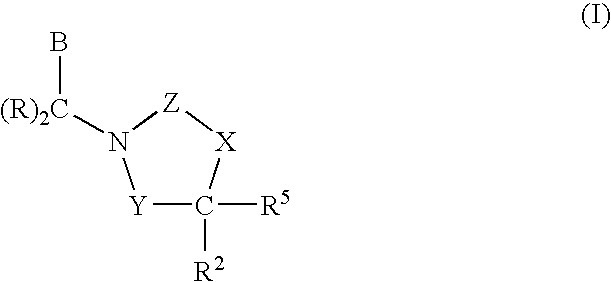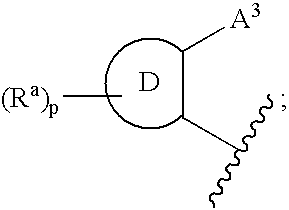Cetp Inhibitors
a technology of hdl-c and inhibitors, applied in the field of ccetp inhibitors, can solve the problems of chd risk, high risk of statins, and true burden on health care systems, and achieve the effect of only reducing the risk of approximately one-third
- Summary
- Abstract
- Description
- Claims
- Application Information
AI Technical Summary
Problems solved by technology
Method used
Image
Examples
example 1
[0236]
(4S,5R)-5-[3,5-Bis(trifluoromethyl)phenyl]-3-{[5-(4-fluoro-5-isopropyl-2-methoxyphenyl)-2-(trifluoromethyl)pyridin-4-yl]methyl}-4-methyl-1,3-oxazolidin-2-one
Step A: 4-methyl-5-nitro-2-(trifluoromethyl)pyridine
[0237]A mixture of 2-bromo-5-nitro-4-pyridine (100 mg, 0.461 mmol), copper (1) iodide (73.1 mg, 0.384 mmol) and methyl 2,2-difluoro-2-(fluorosulfonyl)acetate (177 mg, 117 μL, 0.922 mmol) in dry DMF (1 mL) was heated under N2 at 120° C. overnight. The reaction mixture was cooled to room temperature and diluted with saturated NH4Cl (3.6 mL) and NH4OH (0.4 mL). The mixture was stirred until homogenous (a little water was added). The mixture was extracted with EtOAc (3×20 mL). The combined extracts were washed with brine (10 mL), dried (Na2SO4) and concentrated in vacuo to give the crude product. This was purified by flash chromatography (Si, 12×160 mm, 0-20% EtOAc in hexanes gradient) to afford 4-methyl-5-nitro-2-(trifluoromethyl)pyridine. LCMS calc.=207.1; found=207.1 (M+1)...
example 26
[0244]
(4S,5R)-5-[3,5-bis(trifluoromethyl)phenyl]-3-({6-chloro-3-[5-(2-hydroxy-1,1-dimethylethyl)-2-methoxyphenyl]pyridin-2-yl}methyl)-4-methyl-1,3-oxazolidin-2-one
[0245]To a solution of (4S,5R)-5-[3,5-bis(trifluoromethyl)phenyl]-3-[(3-bromo-6-chloropyridin-2-yl)methyl]-4-methyl-1,3-oxazolidin-2-one (INTERMEDIATE 9) (107.0 mg, 0.207 mmol) and 2-[4-methoxy-3-(4,4,5,5-tetramethyl-1,3,2-dioxaborolan-2-yl)phenyl]-2-methylpropan-1-ol (64 mg, 0.207 mmol) in THF (2.3 mL) was added aqueous potassium carbonate (1.6 mL of a 1M solution, 1.6 mmol). The mixture was degassed with nitrogen. While stirring the reaction vigorously at room temperature, 1,1-bis(di-t-butylphosphino)ferrocene palladium chloride (6.7 mg, 0.01 mmol) was added. The reaction was stirred vigorously at room temperature for 15 min, and then diluted with EtOAc (50 mL). The organics were washed with water and brine (15 mL each). The organic layer was dried over Na2SO4, filtered, and concentrated. Purification of the residue by f...
example 28
[0247]
(4S,5R)-5-[3,5-bis(trifluoromethyl)phenyl]-3-{[3-(4-fluoro-5-isopropyl-2-methoxyphenyl)-6-isopropenylpyridin-2-yl]methyl}-4-methyl-1,3-oxazolidin-2-one
[0248]A mixture of (4S,5R)-5-[3,5-bis(trifluoromethyl)phenyl]-3-{[6-chloro-3-(4-fluoro-5-isopropyl-2-methoxyphenyl)pyridin-2-yl]methyl}-4-methyl-1,3-oxazolidin-2-one (EXAMPLE 18) (43 mg, 0.071 mmol) and isopropenyl boronic acid (Molander, G. A.; et. al. J. Am. Chem. Soc. 2003, 125, 11148-11149) (122 mg, 1.42 mmol) in THF (3 mL) and 1N aqueous potassium carbonate (3 mL). 1,1-Bis(di-t-Bu-phosphino)ferrocene palladium dichloride (4.6 mg, 0.0071 mmol) was heated at 80° C. for 4 h in a sealed tube. The mixture was cooled to room temperature and filtered through Celite. The filtrate was diluted with water and extracted with EtOAc (3×). The combined organic extracts were washed with brine (1×), dried (Na2SO4) and concentrated in vacuo. The residue was purified by flash chromatography (Si, hexanes / EtOAc) to afford (4S,5R)-5-[3,5-bis(tri...
PUM
 Login to View More
Login to View More Abstract
Description
Claims
Application Information
 Login to View More
Login to View More - R&D
- Intellectual Property
- Life Sciences
- Materials
- Tech Scout
- Unparalleled Data Quality
- Higher Quality Content
- 60% Fewer Hallucinations
Browse by: Latest US Patents, China's latest patents, Technical Efficacy Thesaurus, Application Domain, Technology Topic, Popular Technical Reports.
© 2025 PatSnap. All rights reserved.Legal|Privacy policy|Modern Slavery Act Transparency Statement|Sitemap|About US| Contact US: help@patsnap.com



